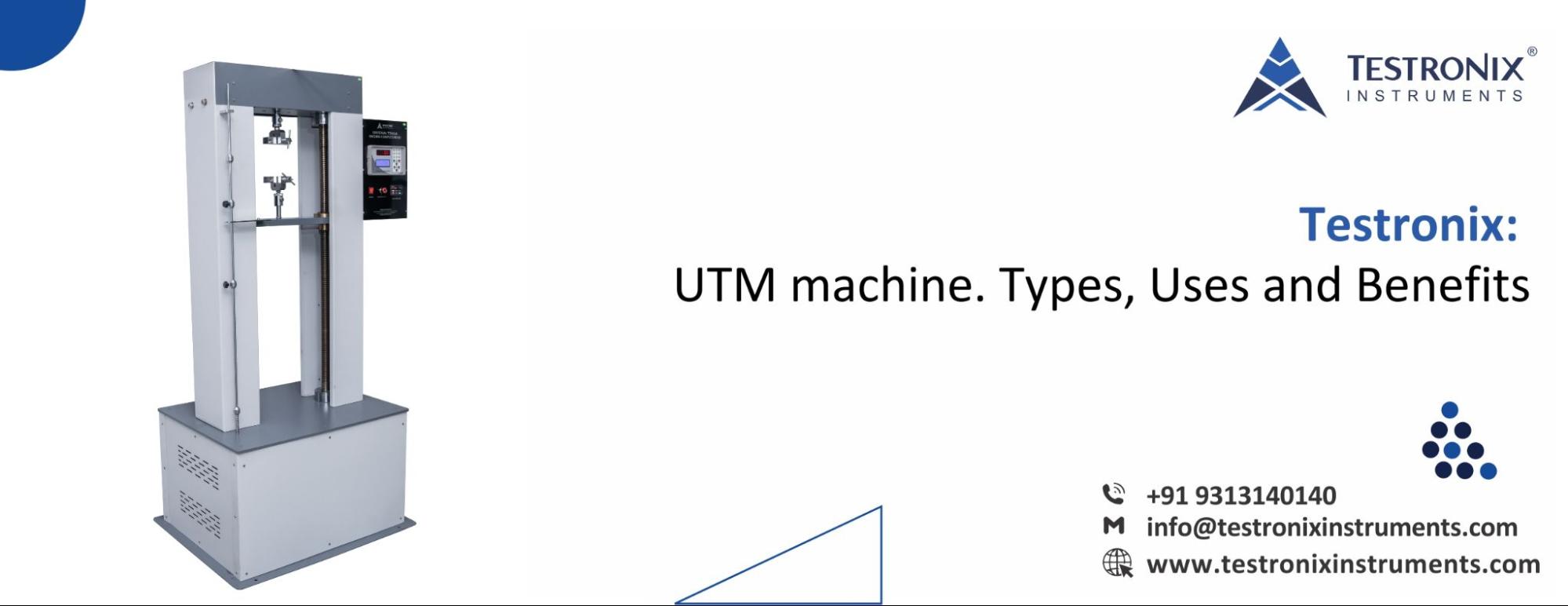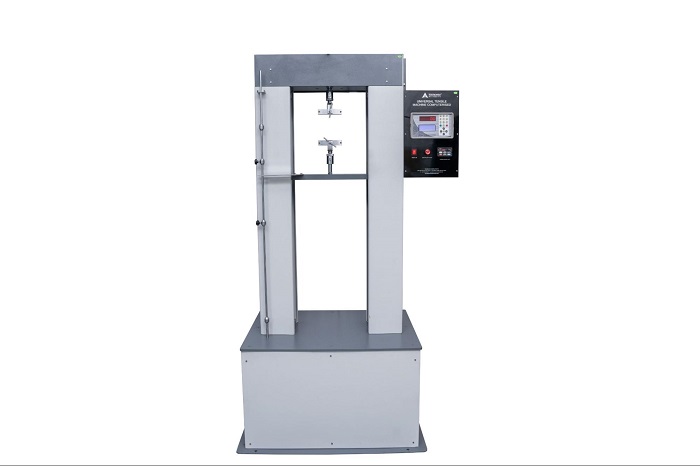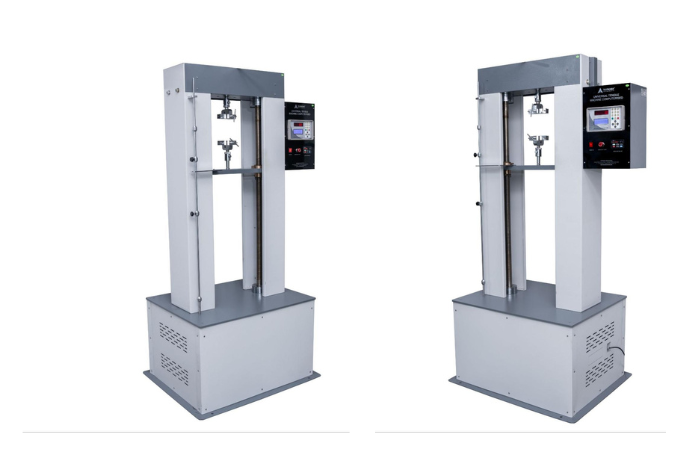Reviewed by Anurag Mishra (Sr. Technical Consultant)

In the manufacturing and engineering industries, ensuring precise measurements and high-quality production is a significant challenge. Traditional measuring techniques often lead to inaccuracies, resulting in defective products, increased material waste, and additional costs.
To overcome these issues, Universal Testing Machine (UTM) provide an efficient solution by accurately evaluating the mechanical properties of materials, such as tensile strength, compression, and elongation. In this discussion, we will explore the working principle of UTM, its types, key components, and its applications across various industries.
A Universal Testing Machine, or UTM tests the strength, durability, and mechanical properties of materials. It exerts the controlled force to determine tensile, compressive, and shear strength, and helps industries guarantee material quality and safety. UTMs are used to assess how materials behave under various loads.

They are capable of evolving interchangeable parts, which enables them to follow different testing requirements, making them key equipment in manufacturing, construction, aerospace, and scientific research.
The main purpose is to check, and research the mechanical properties of the material, that the manufacturers intend to use for production. This machine works on the principle of, how much power a material can deal with, prior to its breakage, up to what amount can it curve, or what answers it has for various burdens.
A Universal Testing Machine (UTM) operates by imposing controlled force on a material to evaluate its mechanical properties such as tensile strength, compression, and elongation. The equipment is made up of a load frame, grips, a load cell, and a control panel or computer program for data processing.
A specimen is positioned between the grips, and force is slowly applied until it deforms or fractures. To implement an experiment, the sample is fixed securely into the load frame, and the load is applied by a force measurement device, known as a load cell or hydraulic actuator.
When the load is exerted, the specimen distorts, and this deformation is evaluated by a displacement transducer. The load and deformation information is collected and evaluated to assess the mechanical functionalities of the sample. Here are the key steps explaining how UTM Machine operates:
The initial phase of using a Universal Testing Machine involves preparing the test specimen and properly securing it. The sample is typically prepared according to established standards, like ISO. The specimen's dimensions and form may vary on the test being conducted.
After the specimen is properly secured in the UTM, the machine exerts force. The nature of the force whether it is tensile, compressive or another type depends on the specific tests. The movement of the crosshead, which applies the force, is regulated by the UTM’s actuator which can be hydraulic, or electromechanical.
As the UTM exerts force on the specimen, the next critical step is precisely recording the material’s response. This process relies on two major components: the load cell which quantifies the applied force or displacement transducers which monitor the extent of deformation under stress.
After the UTM applies force and measures the sample’s response, the final step is analyzing and recording the collected data. This step is critical for understanding the material's mechanical properties, as it provides insights into how the material performs under stress.
The UTM’s control system, usually equipped with advanced software, automatically compiles data points such as maximum load, deformation, yield strength, and elongation at break.
Universal Testing Machines (UTMs) are load-capacity classified into three categories: high-capacity (1000+ kN) for dense materials such as metals and concrete, medium-capacity (100–1000 kN) for plastics and automotive components, and low-capacity (less than 100 kN) for lightweight materials such as textiles and thin metal. Here are the more detailed explanations -
A low-capacity Universal Testing Machine (UTM) is designed for testing materials with lower force requirements. It typically operates electromechanically, offering precise control for evaluating lightweight materials, polymers, and small-scale specimens.
Range: Upto 20 Kgf to 100 Kgf (50 Kgf)
Highlights:
Accuracy Testing: Ideal for testing small samples, and sensitive materials, with a serious level of precision.
Applications: Utilized in research labs, and quality control for materials like plastics, materials, and little metal examples.
A Medium Capacity UTM Machine is designed for testing materials with moderate load requirements. It typically ranges from 50 kN to 600 kN, balancing precision and strength for various mechanical tests, including tensile, compression, and flexural analysis.
Range: more than 100 Kgf to 1000 Kgf (250 Kgf, 500 Kgf)
Highlights:
Utilization: It is reasonable to test a wide variety of materials, such as polymers, composites, etc.
Applications: UTM of this range is typically used in industries like automotive, construction, etc.
A high-capacity Universal Testing Machine (UTM) is designed for testing materials that require extremely high loads. It typically operates using hydraulic systems, allowing precise application of force for evaluating strength, durability, and deformation.
Range: more than 1000 Kgf to 10000 Kgf (2500 Kgf)
Highlights:
Utilization: it is specifically intended to be used for weighty, and strong materials, such as concrete, steel, etc
Applications: This UTM is used in large-scale manufacturing industries. In such industries hard core materials are tested to determine their durability and strength, these industries are aerospace, infrastructure, shipbuilding, etc.
A Universal Testing Machine (UTM) is a flexible and commonly utilized device in material testing. It is capable of conducting various tests including tension, compression, and shear tests, on different materials like plastics, metals, and composites. Here are some key benefits of using a UTM Machine:

A Universal Testing Machine for Tensile Tests can conduct a wide range of tests, making it a highly versatile tool in both research and industrial settings. It can test materials under different loading conditions, including tensile, compressive, and flexural loads. Universal Testing Machines for Tensile Tests can test various materials such as metals, polymers, textiles, rubber, and composites, making it an essential tool across multiple industries.
UTMs are designed to provide highly accurate measurements of material properties like tensile strength, yield strength, and elongation at break. This accuracy is critical in ensuring the reliability and safety of materials used in manufacturing and construction. Universal Testing Machines for Tensile Tests are equipped with advanced load cells and extensometers that ensure consistent and repeatable test results, which is essential for quality control and material certification.
Modern universal testing machines come with user-friendly software interfaces that allow operators to easily set up tests, monitor progress, and analyze results. This reduces the learning curve and allows for efficient operation even by less experienced technicians.
Universal testing machines can record and output a wide range of data points, which can be used for detailed analysis of material properties. This data is crucial for understanding the performance characteristics of materials under different conditions.
Universal testing machines are built to withstand heavy use and harsh testing environments. Their robust construction ensures long-term reliability and minimal maintenance, providing a good return on investment.
Universal testing machines are designed to meet international testing standards such as ASTM, ISO, and DIN. This ensures that the tests performed comply with global industry requirements, which is crucial for product certification and regulatory approval.
UTM helps manufacturers improve the existing materials, and develop new materials. It is done by testing various mechanical properties, to observe how they react when put under pressure.
This test helps in deciding how materials stretch under strain. In order to check the rigidity, extension, and elongation of the material this test is considered essential.
The compressive power of the materials can be tested by conducting this test.
It measures a material’s protection from tearing. This test is valuable for materials like elastic, and plastics where strength against tearing is basic.
UTM machine works on the principle of Hooke's Law for elastic deformation and Newton's Third Law for equilibrium of forces. It is based on the application of a controlled force to a test specimen and the measurement of its response to ascertain mechanical properties such as tensile, compressive, and flexural strength. A load is applied progressively through a hydraulic or electromechanical system, and force and displacement are measured by sensors. The test is conducted until the material either deforms or breaks, producing a stress-strain curve for examination.
A Universal Testing Machine (UTM) is used to test the mechanical characteristics of materials, such as tensile, compressive, bending, and shear strength. It assists in maintaining material quality, durability, and conformity to specifications for industries such as manufacturing, construction, aerospace, and automobile.
The software plays a significant role in controlling the UTM. It helps in the machine’s functioning, conducting calculations, preparing reports, recording the data, and providing a graphical representation of the data.
Yes. UTM machine is fit to test various non-metallic materials such as rubbers, polymers, composites, etc. According to testing of various materials, the machine can be furnished with specific installations to ensure accurate results.
In order to get dependable experimental results, and ensure accuracy in the data, it becomes important to prepare the sample beforehand.